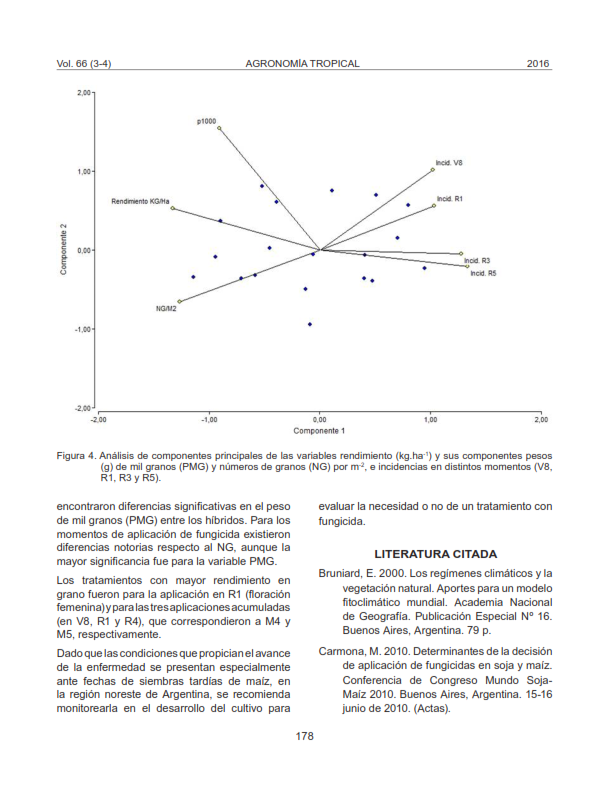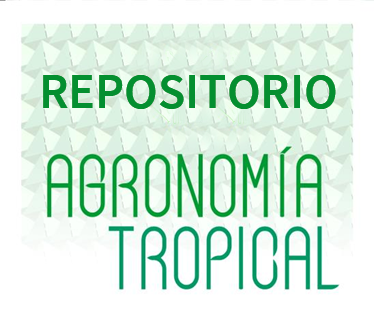Effect of fungicide application for leaf blight control on yield components in maize hybrids
Abstract
Corn crop (Zea mays L.) is continuously exposed to several biotic stresses. The situation that is accentuated in northern Argentina, where the most frequent disease that affects it is the leaf blight caused by Exserohilum turcicum. In order to evaluate the effect of the application of fungicides for the control of leaf blight on the performance components of corn hybrids, an experiment was installed at the National University of the Northeast (UNNE), Corrientes, Argentina. Four hybrids (‘P1833H’, ‘31Y05HR’, ‘P2049H’ and ‘P1780Y’) planted-late were evaluated, in combination with five moments of a fungicide application. The moments with fungicide (Picoxystrobin 20% + Cyproconazole 8%) were: untreated control (M1), application between V8 and V10 (M2), application at R1 (M3), application at R4 (M4), and the three joint applications (2 + 3 + 4) (M5). The incidence of blight, biomass, yield in grain and its components was analyzed. Statistically significant differences were found in yield, with respect to hybrids and application moment (p = 0.0001). At R5, the lower levels of incidence were found for the R1 application moment (M3) and for the three applications (M5). Regarding the components of the yield, among the treatments with fungicide, the variable affected was the thousand grains weight (TGW).In addition, the number of grains (NG) also showed significant differences, although with greater emphasis on hybrids (P=0.0001). The incidence of leaf blight negatively affected the yield, with a reduction in the number of grains at early stages and restriction of grain filling in the late stages.
Downloads
References
• Carmona, M. 2010. Determinantes de la decisión de aplicación de fungicidas en soja y maíz. Conferencia de Congreso Mundo Soja- Maíz 2010. Buenos Aires, Argentina. 15-16 junio de 2010. (Actas).
• Couretot, L. 2011. Principales enfermedades del cultivo de maíz. VI Jornada de Actualización Técnica de Maíz. Pergamino, Argentina. 9 Agosto de 2011. (Actas).
• Couretot, L; Parisi, L; Ferraris, G; Magnone, G. 2012. Efecto de fungicidas foliares y momento de aplicación sobre la severidad de tizón foliar y enfermedades de raíz y tallo en maíz. XIV Jornadas Fitosanitarias Argentinas. 65 p. (Resúmenes).
• De Souza, J. 2007. Enfermedades del maíz en Entre Ríos. Actualización Técnica. Maíz, Girasol y Sorgo. INTA EEA Paraná, Argentina. Serie Extensión Nº 44: 80-85.
• Di Rienzo, JA; Casanoves, F; Balzarini, MG; González, L; Tablada, M; Robledo, CW. 2012. InfoStat versión 2012 (en línea). Grupo InfoStat, Facultad de Ciencias Agropecuarias, Universidad Nacional de Córdoba, Argentina. Disponible en: https://bit.ly/2Hjxnde
• Escobar, EH; Ligier, D; Melgar, M; Matteio, H; Vallejos, O. 1996. Mapa de suelos de los Departamentos de Capital, San Cosme e Itatí de la Provincia de Corrientes, Argentina. Publicación del Convenio del Instituto Nacional de Tecnología Agropecuaria (INTA-ICA) y Provincia de Corrientes-CFI, Argentina. 129 p.
• Formento, AN; Vicentín, G. 2005. Mancha ocular en maíz (Aureobasidium zeae Syn. Kabatiella zeae). INTA EEA Paraná, Argentina. Consultado: 02 dic. 2013. Disponible en: https://bit.ly/2vtKtC0
• García M, PJ; Cabrera P, SR; Sánchez, JJ; Pérez C, AA. 2008. Evaluación de un biofungicida para el control de la mancha bandeada del maíz causada por Rhizoctonia solani Kühn en siembras comerciales en Portuguesa, Venezuela. Agronomía Tropical 58(4): 383-390.
• González, AJ; González-Varela, G. 2007. Ensayos in vitro de fungicidas frente a Exserohilum turcicum, agente causal del tizón norteño del maíz, en Asturias. Boletín Sanidad Vegetal Plagas. 33:289-295.
• Gutiérrez, SA; Cundom, MA; Gasoni, L; Barrera, V. 2007. First record of Rhizoctonia zeae on corn in Argentina. Australasian Plant Disease. Notes 2: 137–138.
• Laguna, IG; Nome, SF; Conci, L; Conforto, C; Eyherabide, G; Giménez MD; Pecci, C; González, M; Guzmán, F; Incremona, M; Lenardon, S; Marino de Remes, AM; Pérez, BA; Presello, D; Rodríguez Pardina, P; Sagadin, M; Sillón, M; Truol, G; Copia, P; Botta, G. 2010. Enfermedades de Zea mays L. (maíz) en Argentina. Atlas Fitopatológico Argentino 3(1). Eds. Nome, SF; Docampo, DM y Conci, LR. ISSN 1851-8974.
• Lafitte, HR. 1994.Identifying Production Problems in Tropical Maize: A Field Guide. México, D.F. CIMMYT. 122 p.
• Ritchie, SW; Hanway, JJ; Benson, GO. 1986. How a corn plant develops. Iowa State Univ. Coop. Ext. Serv. Spec. Rep. 48. 21 p.
• Romero, JL; Cúndom, MA; Bóbeda, G; Galdeano, E. 2012. Curvas de progreso del tizón foliar del norte y la roya común del maíz en Chaco, Argentina. Congreso Paulista de Fitopatología. San Pablo, Brasil. 14-16 febrero de 2012. (Actas).
• Shaner, G; Buechley,G; Johnson, R. 2006. Control of leaf diseases of seed corn in Indiana with foliar fungicides, 2005. F&N Tests, Report No. 61:FC037.
• Tambussi, EA. 2004. Fotosíntesis, fotoprotección, productividad y estrés abiótico: algunos casos de estudio. Tesis de Doctorado. Universidad de Barcelona, España. 42 p.
• White, DG. 1999. Compendium of corn diseases. Ed. American Phytopathological Society, St. Paul, MN., USA. 3rd Ed. 78 p.





